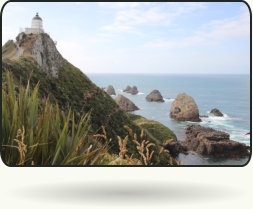

Nature Trails
Porpoise Bay
The beautiful sandy curve of Porpoise Bay forms superb rolling breakers where Hector’s dolphins love to surf.Petrified Forest on the beach
By the late Jurassic period, New Zealand was an extensive landmass linked to nearby parts of Gondwana (Australia/Antarctica). At that time Curio Bay was a broad floodplain flanked by active volcanoes which flooded the forests with volcanic debris. The lower parts of the trees were buried and turned to stone. The trunks that lie exposed were carried in by the flood and were partially buried. Due to the very complete nature of this process known as ‘silification’, the petrified wood and its texture are of an unusually high quality. It looks very much like real wood yet feels just like stone. Curio Bay is the site of one of the world’s finest fossil forests. The platform of petrified stumps, fallen trees and fern imprints are easily accessible at low tide, or can be viewed from the platform above. Just before dusk up to a dozen yellow- eyed penguins stagger ashore to their burrows in the bushes at the back of Curio Bay.MacLean Forest
The 22 metre falls are on the Tautuku River in Catlins Conservation Park and are often described as the most spectacular in the region. The walk to the falls, though uphill, is not too steep and very pleasant. It passes through a variety of forest and shrub types: huge tree fuchsia, stands of olearia and podocarp forest.
Cathedral Caves
At 199 metres total passage length, Cathedral Cave on Waipati Beach is one of the 30 longest known sea caves in the world. Cathedral Caves are only accessible two hours before and up to two hours after low tide. The 40 minute return walk winds down to the beach through dense bush and then a short distance along Waipati beach. Access to the caves may be closed, even at low tide, due to inclement weather. $5 entry charge.Lake Wilkie
It’s a short walk to a boardwalk over part of the lake. When the rata is in flower around the viewing area, there can be a magnificent array of colour as well as birdsong as tui and bellbirds enjoy the nectar. The forest is old- growth mixed podocarp. Easy Walking - 20 minutes return.

Purakanui Falls
These falls have long been a trademark of the Catlins. The walk to the top viewing point is an interpretative walk, highlighting many native trees and shrubs. Easy Walking - 20 minutes return.Cannibal Bay / Surat Bay
This is a wonderful place to look out for New Zealand sea lions. Surat Bay owes its name to the ship, Surat, wrecked on the bar, on New Year’s Day 1874. Cannibal Bay was the site of early Maori encampments. The beaches are wild and beautiful and well worth visiting. There is a good coastal walk that links Cannibal and Surat Bays.Nugget Point
This is a 47 hectare wildlife reserve and is home to many of the southern coast’s animals and birds, including elephant seals, fur seals, New Zealand (Hooker’s) sea lions, the rare yellow-eyed penguin and many other species of seabirds. There is a 20 minute return walking path to the Roaring Bay viewing hide, as well as a 10-20 minute return walk to New Zealand’s oldest Lighthouse buit in 1849.



There are endless trekking choices
in the Catlins, both inland and on
the coast. The native forests are
home to many species of podocarp
trees. Other trees include silver
beach, tawhai and flowering
kamahi and rata. There are many
perching plants, orchids, vines and
28 species of fern.






















